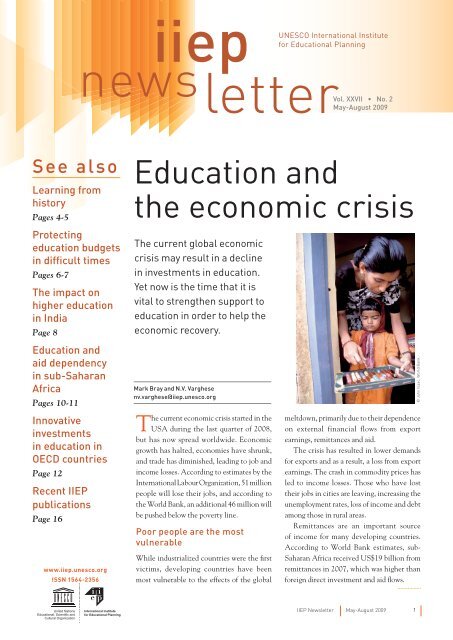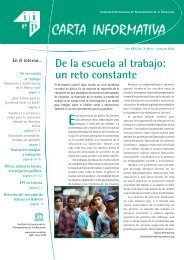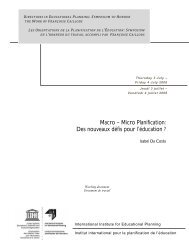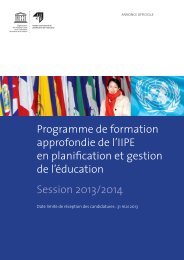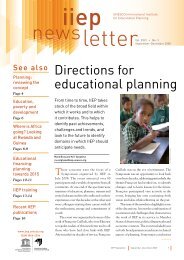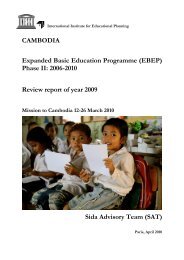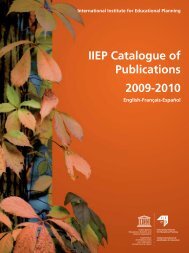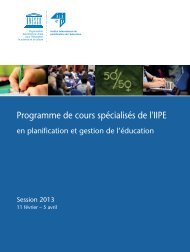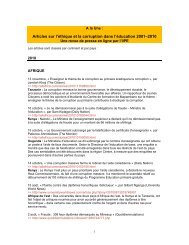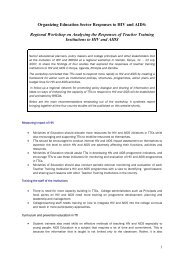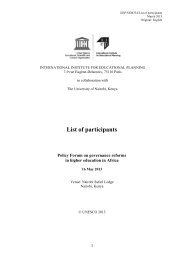Education and the economic crisis - IIEP - Unesco
Education and the economic crisis - IIEP - Unesco
Education and the economic crisis - IIEP - Unesco
Create successful ePaper yourself
Turn your PDF publications into a flip-book with our unique Google optimized e-Paper software.
iiepUNESCO International Institutefor <strong>Education</strong>al Planningnews letterVol. XXVII • No. 2May-August 2009See alsoLearning fromhistoryPages 4-5Protectingeducation budgetsin difficult timesPages 6-7The impact onhigher educationin IndiaPage 8<strong>Education</strong> <strong>and</strong>aid dependencyin sub-SaharanAfricaPages 10-11Innovativeinvestmentsin education inOECD countriesPage 12Recent <strong>IIEP</strong>publicationsPage 16www.iiep.unesco.orgISSN 1564-2356<strong>Education</strong> <strong>and</strong><strong>the</strong> <strong>economic</strong> <strong>crisis</strong>The current global <strong>economic</strong><strong>crisis</strong> may result in a declinein investments in education.Yet now is <strong>the</strong> time that it isvital to streng<strong>the</strong>n support toeducation in order to help <strong>the</strong><strong>economic</strong> recovery.Mark Bray <strong>and</strong> N.V. Varghesenv.varghese@iiep.unesco.orgThe current <strong>economic</strong> <strong>crisis</strong> started in <strong>the</strong>USA during <strong>the</strong> last quarter of 2008,but has now spread worldwide. Economicgrowth has halted, economies have shrunk,<strong>and</strong> trade has diminished, leading to job <strong>and</strong>income losses. According to estimates by <strong>the</strong>International Labour Organization, 51 millionpeople will lose <strong>the</strong>ir jobs, <strong>and</strong> according to<strong>the</strong> World Bank, an additional 46 million willbe pushed below <strong>the</strong> poverty line.Poor people are <strong>the</strong> mostvulnerableWhile industrialized countries were <strong>the</strong> fi rstvictims, developing countries have beenmost vulnerable to <strong>the</strong> effects of <strong>the</strong> globalmeltdown, primarily due to <strong>the</strong>ir dependenceon external financial flows from exportearnings, remittances <strong>and</strong> aid.The <strong>crisis</strong> has resulted in lower dem<strong>and</strong>sfor exports <strong>and</strong> as a result, a loss from exportearnings. The crash in commodity prices hasled to income losses. Those who have lost<strong>the</strong>ir jobs in cities are leaving, increasing <strong>the</strong>unemployment rates, loss of income <strong>and</strong> debtamong those in rural areas.Remittances are an important sourceof income for many developing countries.According to World Bank estimates, sub-Saharan Africa received US$19 billion fromremittances in 2007, which was higher thanforeign direct investment <strong>and</strong> aid fl ows.© John Isaac, World Bank.International Institutefor <strong>Education</strong>al Planning<strong>IIEP</strong> Newsletter May-August 2009 1
At <strong>the</strong> same time, many developingcountries are dependent on aid, especially<strong>the</strong> countries recovering from confl ict.Crises of this sort are often associatedwith cuts in aid. Aid has been on <strong>the</strong>decline, <strong>and</strong> may be reduced fur<strong>the</strong>r in2009 by an estimated US$20 billion.Income from tourism is decliningin Asia <strong>and</strong> Africa. Similarly, due to afall in oil prices, incomes have fallenin oil-exporting countries, which arereducing <strong>the</strong>ir budgets (p. 7). Estimatesof <strong>the</strong> impact of <strong>the</strong> <strong>crisis</strong> show that morepeople will be thrown into poverty.<strong>Education</strong> financingAccording to <strong>the</strong> 2009 <strong>Education</strong> forAll (EFA) Global Monitoring Report(GMR), nearly 75 million children areout of school. Governments <strong>and</strong> <strong>the</strong>global community will fall short of <strong>the</strong>goal of universal primary education in2015 by around 30 million children.Most of <strong>the</strong>se children will be from poorfamilies in poor countries (p. 4).Poor countries were already investingless than <strong>the</strong> required amount ineducation <strong>and</strong> health <strong>and</strong> <strong>the</strong> <strong>crisis</strong> iseroding <strong>the</strong>ir ability to maintain even<strong>the</strong>se levels. Many countries dependon aid for basic education, <strong>and</strong> thisdependence is increasing, even thoughaid flows are not showing signs ofincrease.Aid to education was on <strong>the</strong> riseat <strong>the</strong> beginning of <strong>the</strong> 2000s, beforeit fell from US$5.5 billion in 2006 toUS$4.3 billion in 2007, according to<strong>the</strong> OECD’s Development AssistanceCommittee. This aid may fur<strong>the</strong>r dropby US$1.1 billion by 2010. According to<strong>the</strong> GMR, US$11 billion is needed in aidannually to attain EFA in poor countries,with <strong>the</strong> 2007 provision totalling a mereUS$2.5 billion – less than four times <strong>the</strong>required amount (p. 10).In higher education, some countriesare less affected by <strong>the</strong> <strong>crisis</strong> thano<strong>the</strong>rs. The <strong>economic</strong> <strong>crisis</strong> has led toreduced public funding in <strong>the</strong> sector,with reprioritization in favour ofprimary education (p. 8). Due to fewerstudents being able to pay fees, privateuniversities may struggle to survive.However, one factor which may increasedem<strong>and</strong> would be <strong>the</strong> decision by youngpeople to gain more education in orderto improve <strong>the</strong>ir prospects of securingjobs. The <strong>crisis</strong> may be felt more in <strong>the</strong>area of research than in enrolment <strong>and</strong>teaching because research provides lesstangible <strong>and</strong> immediate <strong>economic</strong> <strong>and</strong>social returns.Political prioritizationPoor people in poor countries are notresponsible for <strong>the</strong> <strong>crisis</strong>, although<strong>the</strong>y suffer <strong>the</strong> consequences most(p. 5). Political prioritization <strong>and</strong>financial support must favour <strong>the</strong>mmore than o<strong>the</strong>rs <strong>and</strong> education mustbe streng<strong>the</strong>ned to support <strong>economic</strong>recovery.Governments need to be pressurizedto prioritize investment in education,communities to support education efforts(p. 11), bilateral donors to increase <strong>the</strong>ircontributions, multilateral agencies tomaintain <strong>the</strong>ir support, <strong>and</strong> institutionsto use available resources efficiently(p. 6 <strong>and</strong> p. 12). <strong>Education</strong> is an integralpart of recovery plans in many countries(p. 9), including <strong>the</strong> stimulus packagedevised by <strong>the</strong> US government to revive<strong>the</strong> economy through public expenditure<strong>and</strong> tax measures.Unlike in earlier crises, at least somerecovery plans include investmentin education <strong>and</strong> training. This ishighly desirable, <strong>and</strong> requires support,protection <strong>and</strong> extension where <strong>the</strong>education sector is threatened. ■Web focus on higher educationTo coincide with <strong>the</strong> UNESCO World Conference on Higher <strong>Education</strong> <strong>and</strong> <strong>the</strong> <strong>IIEP</strong> PolicyForum on Tertiary education in small states in July 2009, <strong>IIEP</strong> held a web focus on <strong>the</strong> topic.The challenges faced around <strong>the</strong> world were divided into six main <strong>the</strong>mes:• Globalization• Privatization• Quality assurance• Research <strong>and</strong> development• Governance <strong>and</strong> management• Rural development <strong>and</strong> poverty alleviationwww.iiep.unesco.org/focus-on-higher-education.html© François Le Gall, World Bank.2 <strong>IIEP</strong> Newsletter May-August 2009
editorialMark BrayDirector of <strong>IIEP</strong>m.bray@iiep.unesco.orgNew complexitiesin a changing world<strong>IIEP</strong>’s m<strong>and</strong>ate requires <strong>the</strong> Institute to pay special attention to those livingin poverty. During <strong>the</strong> <strong>economic</strong> <strong>crisis</strong>, since late 2008, <strong>the</strong> number of peopleliving in poverty has increased. <strong>IIEP</strong> <strong>the</strong>refore, now has increased responsibilities<strong>and</strong> new challenges.When <strong>the</strong> global <strong>economic</strong> <strong>crisis</strong> hit, <strong>the</strong> <strong>IIEP</strong> leadership reviewed itsEighth Medium-Term Plan (2008-2013) to see what reorientations were needed.Although it was agreed that <strong>the</strong> basic structure <strong>and</strong> focus of <strong>the</strong> Plan remainrobust <strong>and</strong> pertinent, it is clear that various adjustments are necessary. Lowincomecountries, which <strong>IIEP</strong> particularly aims to serve, have been affectedthrough no fault of <strong>the</strong>ir own, <strong>and</strong> some of <strong>the</strong> high-income countries withwhich <strong>the</strong> Institute has collaborated have had to reorient <strong>the</strong>ir <strong>economic</strong> <strong>and</strong>social approaches as well as restructure <strong>the</strong>ir external assistance. Like many ofits counterparts around <strong>the</strong> globe, <strong>IIEP</strong> has found that <strong>the</strong> context in which itfunctions has changed considerably.<strong>IIEP</strong> has formulated various responses to <strong>the</strong>se changing circumstances: We have stressed <strong>the</strong> value of education as a long-term investment <strong>and</strong> arehighlighting <strong>the</strong> dangers that can arise from short-term cuts. We have emphasized <strong>the</strong> need for strategic planning that takes account of risks aswell as opportunities in <strong>the</strong> volatile environments in which we work. We are monitoring <strong>the</strong> impact of <strong>the</strong> <strong>crisis</strong> through studies on household costs ofeducation in countries in West Africa, on international aid fl ows, <strong>and</strong> on stateswhich were already fragile prior to <strong>the</strong> <strong>crisis</strong>. As an intellectual as well as practical organization, <strong>IIEP</strong> is analysing <strong>the</strong> conceptualimplications of <strong>the</strong> <strong>crisis</strong> on planning itself.The events since <strong>the</strong> onset of <strong>the</strong> <strong>crisis</strong> have also changed <strong>the</strong> nature of socialinequalities. Relatively rich countries, such as Icel<strong>and</strong>, have found <strong>the</strong>mselves insevere diffi culty. At <strong>the</strong> o<strong>the</strong>r end of <strong>the</strong> scale, economies based on subsistenceagriculture have been largely untouched: <strong>the</strong>y were poor before <strong>the</strong> <strong>crisis</strong> <strong>and</strong><strong>the</strong>y will be poor after <strong>the</strong> <strong>crisis</strong>. The previously well-off oil-based economieshave suffered a blow <strong>and</strong> consider <strong>the</strong>mselves worse-off – but only relative to<strong>the</strong>ir earlier income levels. Many societies which had depended on remittancesfrom migrant workers – such as Cuba <strong>and</strong> Tonga – have had to make majoradjustments.These changing patterns have made it necessary for <strong>IIEP</strong> to shift <strong>the</strong> focusof its work. Member States can be assured of our ongoing commitment topartnerships for devising ways to cushion <strong>the</strong> impact of crises <strong>and</strong> for drawingon lessons learned to implement long-term plans. Among <strong>the</strong> greatest of <strong>the</strong>selessons is that it is becoming harder to predict <strong>the</strong> future in an increasinglyglobalized world. ■In this issue<strong>Education</strong> <strong>and</strong><strong>the</strong> <strong>economic</strong> <strong>crisis</strong> 1editorial:New complexities ina changing world 3Learning from history 4The impact on poverty 5Protecting education budgetsin difficult times 6Oil <strong>and</strong> education in <strong>the</strong> Gulf States 7The impact on highereducation in India 8Latin America <strong>and</strong> <strong>the</strong> <strong>crisis</strong> 9<strong>Education</strong> <strong>and</strong> aid dependencyin sub-Saharan Africa 10Streng<strong>the</strong>ning alternative educationin times of decreasing state funding 11Innovative investments in educationin OECD countries 12Multi-sectoral training on PublicExpenditure Tracking Surveys 13Teachers <strong>and</strong> HIV <strong>and</strong> AIDS:reviewing achievements<strong>and</strong> identifying challenges 132008/2009 ATP study visitto India 14Forthcoming activities 15Obituaries 15<strong>IIEP</strong> Publications 16Printed on recycled paperThe <strong>IIEP</strong> Newsletter is published three times a year inEnglish, French <strong>and</strong> Spanish, <strong>and</strong> twice a year in Russian.All correspondence should be addressed to:The Editor<strong>IIEP</strong> NewsletterInternational Institute for <strong>Education</strong>al Planning7-9 rue Eugène-Delacroix75116 Paris, FranceTelephone: +33.1.45.03.77.00Fax: +33.1.40.72.83.66newsletter@iiep.unesco.orgwww.iiep.unesco.orgInternational Institutefor <strong>Education</strong>al Planning
<strong>Education</strong> <strong>and</strong> <strong>the</strong> <strong>economic</strong> <strong>crisis</strong>Learningfrom historySince <strong>the</strong> SecondWorld War, political<strong>and</strong> financial effortshave permittedconsiderableimprovementsin people’s lives.Investing ineducation <strong>and</strong>training is essentialfor long-term<strong>economic</strong> recovery,<strong>and</strong> must not beoverlooked in <strong>the</strong>current <strong>crisis</strong>.Nicholas Burnett UNESCOn.burnett@unesco.orgThe World Digital Library (www.wdl.org),launched at UNESCO in April 2009,includes an iconic photograph by Doro<strong>the</strong>aLange of a destitute mo<strong>the</strong>r with two of herseven children, taken in <strong>the</strong> USA at <strong>the</strong> timeof <strong>the</strong> Great Depression of <strong>the</strong> 1930s.Today’s global <strong>economic</strong> <strong>crisis</strong> is <strong>the</strong> worstsince <strong>the</strong> Great Depression. But we should becautious in drawing too many parallels. Thecurrent <strong>crisis</strong> has erupted in a very differentworld – a globalized world that leaves nocountry untouched. The problems in <strong>the</strong>mortgage market <strong>and</strong> <strong>the</strong> collapse of investmentbanks transformed at lightning speed into afully-fledged <strong>economic</strong> <strong>crisis</strong> that threatens todrive between 50 <strong>and</strong> 90 million people intoextreme poverty. An additional 200,000 to400,000 infants could die each year betweennow <strong>and</strong> 2015. In just a few months, exportdependentcountries registered steep joblosses. We are faced with a global human <strong>crisis</strong>of untold proportions – what <strong>the</strong> World Bankhas described as a development emergency.© Doro<strong>the</strong>a Lange.This calls for a global response initiated by<strong>the</strong> world’s industrialized countries, even in<strong>the</strong> context of negative or stagnant <strong>economic</strong>growth forecasts. The experience of <strong>the</strong> GreatDepression is invoked with <strong>the</strong> reinforced roleof <strong>the</strong> state through a massive fi scal stimuluspackage aiming to revive <strong>the</strong> economy. But<strong>the</strong> comparison should stop <strong>the</strong>re.Today’s world is built on <strong>the</strong> ruins of <strong>the</strong>Second World War <strong>and</strong> on <strong>the</strong> conviction thatinternational cooperation <strong>and</strong> underst<strong>and</strong>ingare a defence against extremist ideologies,oppression <strong>and</strong> tyranny. It is built on <strong>the</strong>conviction, in <strong>the</strong> words of <strong>the</strong> 1948 UniversalDeclaration of Human Rights, that “all humanbeings are born free <strong>and</strong> equal in dignity <strong>and</strong>rights”. The Declaration establishes educationas one of <strong>the</strong>se fundamental rights.We have multilateral institutions thatare now over 60 years old. Whatever <strong>the</strong>irshortcomings, <strong>the</strong> UN <strong>and</strong> o<strong>the</strong>rs havehelped to shape a global conscience, promotepeace, defend human rights <strong>and</strong> improvepeople’s lives around <strong>the</strong> world. The fact that190 countries rallied in 2000 around a set ofgoals (<strong>the</strong> Millennium Development Goals)to halve extreme poverty <strong>and</strong> hunger, reducechild <strong>and</strong> maternal mortality, get all childreninto school, <strong>and</strong> ensure environmentalsustainability, is a sign that a collective willexists to reduce <strong>the</strong> intolerable gap betweenrich <strong>and</strong> poor <strong>and</strong> give every person a moredignifi ed existence. The <strong>Education</strong> for All(EFA) goals adopted <strong>the</strong> same year in Dakar,Senegal, fur<strong>the</strong>r highlight <strong>the</strong> importanceof learning opportunities as a right <strong>and</strong> adevelopment imperative.We have information <strong>and</strong> communicationtechnologies that spread news <strong>and</strong> knowledgeat unprecedented speed <strong>and</strong> permit networking<strong>and</strong> mobilization on a global scale. We haveelectoral democracies, however imperfect, intwo thirds of <strong>the</strong> world’s states, <strong>and</strong> infl uentialcivil society movements.We have witnessed <strong>the</strong> rise of a middleclass in several of <strong>the</strong> world’s largest emergingeconomies, <strong>and</strong> since 2000 we had experiencedsustained <strong>economic</strong> growth – growth thathas been partly responsible for Africa’s rapidprogress towards universal primary education.4 <strong>IIEP</strong> Newsletter May-August 2009
<strong>Education</strong> <strong>and</strong> <strong>the</strong> <strong>economic</strong> <strong>crisis</strong>Recent <strong>economic</strong> crises fromPeru to Russia give us insight <strong>and</strong>warnings. Poverty increases <strong>and</strong> <strong>the</strong>most vulnerable are hardest hit. Childmortality <strong>and</strong> malnutrition rise. An <strong>IIEP</strong>study of <strong>the</strong> Asian <strong>crisis</strong> of <strong>the</strong> late 1990sfound that health <strong>and</strong> education budgetsdeclined in several countries (Malaysia,Indonesia, Thail<strong>and</strong> <strong>and</strong> Philippines). 1Parents withdrew older children fromschool, <strong>and</strong> delayed <strong>the</strong> entry of <strong>the</strong>youngest. Child labour increased inseveral countries. But paradoxically,dem<strong>and</strong> for <strong>the</strong> public provision ofeducation rose in Asia as parents pulledchildren out of private schools.Dependence on aid makes low-incomecountries all <strong>the</strong> more vulnerable.Evidence suggests that a 1 per cent dropin donor country gross domestic product(GDP) is associated with a 1 per centdrop in aid fl ows.The lessons from this are clear: Policies must protect those who aremost vulnerable. Several East Asiancountries introduced social safetynets in <strong>the</strong> 1990s, including transfersof funds to families to keep childrenin school. Singapore pledged not tocut its research <strong>and</strong> developmentbudget in order to maintain itscompetitiveness. Donors must maintain aidcommitments. A combination ofincreased national spending <strong>and</strong> aidled to <strong>the</strong> historic gains in educationacross Africa in <strong>the</strong> past eight years.The 22 per cent drop in aid tobasic education in 2007 seriouslyjeopardizes future progress towards<strong>Education</strong> for All. And this wasbefore <strong>the</strong> <strong>crisis</strong>. A fi scal stimulus package has to bedirected to <strong>the</strong> poorest countries,focusing on <strong>the</strong> poorest people. Itshould provide cash transfers tofamilies to prevent an increase inchild labour, include provisions forschool meals <strong>and</strong> resources for hiringmore teachers.Investing in education <strong>and</strong> trainingis essential to <strong>economic</strong> recovery. In<strong>the</strong> USA, <strong>the</strong> Obama administration’sstimulus package includes US$150billion for education. We need to promotelong-term synergies: public employmentschemes for teachers, scaled-up technical<strong>and</strong> vocational education, with inclusionas <strong>the</strong> backbone of all policies. ■1 Varghese, N.V. 2001. Impact of <strong>the</strong><strong>economic</strong> <strong>crisis</strong> on higher education inEast Asia: country experiences. Paris:<strong>IIEP</strong>-UNESCO.The impacton povertyPauline Rose EFA GlobalMonitoring Report, UNESCOp.rose@unesco.orgMedia attention around <strong>the</strong> <strong>economic</strong> <strong>crisis</strong> has focused mainlyon <strong>the</strong> richest few countries, yet <strong>the</strong> most devastating effectsare on those living in poverty in developing countries.We are all aware that <strong>the</strong>world economy is dealingwith <strong>the</strong> aftershock of afinancial <strong>crisis</strong> which beganin <strong>the</strong> US housing <strong>and</strong>money markets. However,less attention is being paidto <strong>the</strong> ramifications forfour fifths of humanity indeveloping countries.For poor people, <strong>the</strong>global slowdown willtranslate into feweropportunities for incomegeneration, majorjob losses, <strong>and</strong> lowerremittances. Progresstowards poverty reductionwill slow down, <strong>and</strong> mayeven go into reverse.Financial pressures willput government budgetsunder increasing strain, <strong>and</strong>spending in health care <strong>and</strong>education could be an earlycasualty.In many of <strong>the</strong> poorestcountries, <strong>the</strong> financial<strong>crisis</strong> comes against <strong>the</strong>backdrop of high foodprices. Over <strong>the</strong> past twoyears, according to <strong>the</strong>World Food Programme,child malnutrition hasincreased by 77 million.Gains in education builtup since 2000 are also nowunder imminent threat.Governments <strong>and</strong>international agencies –including <strong>the</strong> specializedUN agencies, <strong>the</strong> WorldBank <strong>and</strong> <strong>the</strong> InternationalMonetary Fund (IMF) –have so far failed to shapean effective response.Although <strong>the</strong>re are plentyof ambitious promises, onlyaround US$3 billion a yearin new finance is channelledthrough <strong>the</strong> IMF. It is toolittle, <strong>and</strong> <strong>the</strong> IMF is not<strong>the</strong> right institution to leada poverty-focused fiscalstimulus.What is needed is ascaled-up internationalaid effort. The WorldBank should be providingnew support through <strong>the</strong>International DevelopmentAssociation, <strong>and</strong> bilateraldonors should be deliveringon old aid promises. Thetransfers should comewithout conditionalitystrings. And <strong>the</strong>y shouldstart now. Waiting for‘evidence’ in <strong>the</strong> formof increased dropout,heightened malnutrition,<strong>and</strong> deteriorating healthis a luxury that vulnerablepeople in developingcountries cannot afford. ■<strong>IIEP</strong> Newsletter May-August 2009 5
<strong>Education</strong> <strong>and</strong> <strong>the</strong> <strong>economic</strong> <strong>crisis</strong>Protectingeducationbudgets in© Ami Vitale, World Bank.The financial <strong>crisis</strong> has heightened <strong>the</strong> needto address two closely-related policy challenges.The fi rst is to protect, in <strong>the</strong> short term,current levels of social spending in general,<strong>and</strong> education in particular. The second, in<strong>the</strong> medium to long term, is to protect futurebudgetary allocations in education againstglobal <strong>and</strong> national <strong>economic</strong> volatility.What are <strong>the</strong> options?For <strong>the</strong> short term, policymakers face threeoptions: to reduce spending in education to reallocate funds from o<strong>the</strong>r sectors infavour of education, which is not likely toyield significant amounts in <strong>the</strong> context oflarge fi scal defi cits <strong>and</strong> given <strong>the</strong> politicalbacklash that would almost certainlyensue to seek external funding through additionalaid or foreign borrowing.None of <strong>the</strong>se options would entirely rescueeducation, <strong>and</strong> <strong>the</strong> best approach would be acombination.Debt paymentsdifficult timesAt times whendeveloping countrygovernmentsare forced to cutspending, <strong>the</strong>education sectormust be protected<strong>and</strong> prioritized.Diéry Seck Centre for Research on PoliticalEconomy, Senegal; <strong>IIEP</strong> Governing Boarddieryseck@hotmail.comThe impact of <strong>the</strong> current <strong>economic</strong> <strong>and</strong>fi nancial <strong>crisis</strong> on developing countriesis catastrophic, especially in respect of stunted<strong>economic</strong> growth, unemployment <strong>and</strong> cuts ongovernment spending. <strong>Education</strong> is a primetarget for cuts in times of fiscal strain, given itslarge share in national budgets. It is diffi cultfor developing countries to raise additionalaid to cover shortfalls in education-relatedactivities, unlike humanitarian emergenciesthat can arouse a global sense of solidarityon short notice. Yet, <strong>the</strong> negative impactof under-spending in education on futuregenerations would be irreversible.The international community should alsoconsider o<strong>the</strong>r measures. One bold approachwould be performance-contingent externaldebt service payments. Poor countries wouldbe allowed to postpone part or all of <strong>the</strong>irscheduled external debt service payments if<strong>the</strong>ir <strong>economic</strong> growth falls below an agreedthreshold. Savings from lower external debtservice payments could be earmarked foreducation. Given <strong>the</strong> high debt-to-grossnational product (GNP) proportion of 50 percent <strong>and</strong> above in many African countries, <strong>the</strong>savings could be considerable.Considering that this scheme would makeinternational lenders contingent fi nanciersof education in developing countries,external debt contracted to fi nance educationwould be suitable for this arrangement, <strong>and</strong>concessionary lenders could take <strong>the</strong> lead inassuming <strong>the</strong> shifted risk. However, it wouldbe necessary to ensure that <strong>the</strong> reform providesaid additionally ra<strong>the</strong>r than as a substitute, <strong>and</strong>that developing countries do not pay a risk6 <strong>IIEP</strong> Newsletter May-August 2009
<strong>Education</strong> <strong>and</strong> <strong>the</strong> <strong>economic</strong> <strong>crisis</strong>premium to <strong>the</strong>ir creditors to protect <strong>the</strong>ireducation sectors.<strong>Education</strong> fundingThe second option for global reform rests on <strong>the</strong>view that <strong>economic</strong> growth <strong>and</strong> developmentare based on, <strong>and</strong> also serve, <strong>the</strong> enhancementof human capital. Therefore social spending,including spending on education, must betargeted as a priority in national policy <strong>and</strong> aidprogrammes. Externally-funded developmentprogrammes, particularly in <strong>the</strong> social sector,could be managed by a broadly inclusiveAid Council under <strong>the</strong> auspices of <strong>the</strong> UNthrough a scheme of pooled donor resources.Unconditional funding for education indeveloping countries would shield from <strong>crisis</strong>relatedfinancial shortfalls <strong>and</strong> facilitate longtermplanning in skills training.These reforms could apply to o<strong>the</strong>r sectorsas well. But <strong>the</strong> key challenge is to design <strong>and</strong>implement <strong>the</strong>m now. ■© Ami Vitale, World Bank.Oil <strong>and</strong>educationin <strong>the</strong> GulfStatesDramane Oulaid.oulai@iiep.unesco.orgWith <strong>the</strong> fall in oil prices in <strong>the</strong> Gulf States, education budgetshave been directly affected.In mid-2008, <strong>the</strong> price ofoil was at an all-time highof US$147 a barrel, <strong>and</strong> sowere <strong>the</strong> export revenuesof oil-producing countries,including <strong>the</strong> six Gulf Statesof Bahrain, Kuwait, Oman,Qatar, Saudi Arabia <strong>and</strong><strong>the</strong> United Arab Emirates.With <strong>the</strong> plummetingglobal <strong>economic</strong> growthrates during <strong>the</strong> recession,<strong>the</strong> dem<strong>and</strong> for oil hasdeclined. Oil prices fell aslow as US$37 per barrel,<strong>and</strong> <strong>the</strong> corresponding fallin income affected varioussectors in <strong>the</strong> Gulf States,including education.According to <strong>the</strong> IMFDirector for <strong>the</strong> MiddleEast <strong>and</strong> Central Asia, <strong>the</strong><strong>economic</strong> growth of sixGulf States will decline to3.5 per cent in 2009 from6.8 per cent in 2008. Someof <strong>the</strong>se states, such asOman <strong>and</strong> Saudi Arabia,will experience a recordbudget shortfall this year.Fortunately <strong>the</strong>re aresome <strong>economic</strong> cushions.Some have diversified<strong>the</strong>ir economies to reduce<strong>the</strong>ir dependence on oil,<strong>and</strong> some have built largereserves. These countriesmay be less affected by <strong>the</strong><strong>crisis</strong> in <strong>the</strong> short term.However, some countries,such as Bahrain, areplanning to reduce <strong>the</strong>ireducation budget over <strong>the</strong>coming years.Senior governmentofficials in <strong>the</strong>se statesare voicing more strongly<strong>the</strong> need for prudentmanagement of educationfinancing. At a March 2009seminar, Bahrain’s Ministerof <strong>Education</strong> stressed thatArab Gulf States shouldtake a fresh look at ways toimprove <strong>the</strong> managementof education finances <strong>and</strong> toreduce wastage. 1 Thoughuniversal primary educationhas been achieved inalmost all <strong>the</strong> Gulf States,<strong>and</strong> secondary enrolmentis around 70 per cent,improvement is needed in<strong>the</strong> quality of education.Expansion in private highereducation will continueto be encouraged sincegovernment supportto public universitiescannot keep pace with <strong>the</strong>increasing dem<strong>and</strong>.A fall in <strong>the</strong> oil prices willnegatively impact educationbudgets <strong>and</strong> may adverselyaffect capacity developmentefforts to diversify<strong>the</strong> economy. Fur<strong>the</strong>r,quality improvementprogrammes may be moreaffected than those ofexpansion. However, thisfinancial <strong>crisis</strong> may alsoprovide <strong>the</strong> opportunityfor governments tointroduce reforms toimprove efficiency in <strong>the</strong>management of educationalfinancing. ■1 Seminar on <strong>the</strong> Economics of<strong>Education</strong> in Arab Gulf States,organized by <strong>the</strong> Gulf ArabStates <strong>Education</strong> ResearchCentre (GASERC) <strong>and</strong> <strong>IIEP</strong>,3-5 March 2009.© Péter Gudella, Shutterstock.<strong>IIEP</strong> Newsletter May-August 2009 7
<strong>Education</strong> <strong>and</strong> <strong>the</strong> <strong>economic</strong> <strong>crisis</strong>The impacton highereducationin IndiaWhat is <strong>the</strong> roleof <strong>the</strong> IndianGovernment inprotecting highereducationfrom risks?J<strong>and</strong>hyala B.G. Tilak National University of<strong>Education</strong>al Planning <strong>and</strong> Administration, Indiatilak@nuepa.orgWhen <strong>the</strong> economies around <strong>the</strong> worldbegan to feel <strong>the</strong> impact of <strong>the</strong> globalfi nancial <strong>crisis</strong>, offi cial sources claimed thatIndia would not be too badly affected. Butin no time, rates of <strong>economic</strong> growth beg<strong>and</strong>ropping in all sectors. Companies outsideIndia reduced <strong>the</strong>ir outsourcing <strong>and</strong> laid offmany of <strong>the</strong>ir overseas workers, which couldresult in a return of migrants back to India. Allof this indicates that despite rapidly becomemore globalized, India has not remaineduntouched by <strong>the</strong> <strong>crisis</strong>.What will be <strong>the</strong> effects of <strong>the</strong> <strong>crisis</strong> onhigher education? India’s Eleventh Five-YearPlan (2007-2012), provides a significant© John Isaac, World Bank.increase in budgetary allocations to highereducation in order to achieve a number of‘world class’ universities <strong>and</strong> institutions.It aims to raise <strong>the</strong> gross enrolment ratefrom 11 to 15 per cent. The Plan envisagessupport for expansion from public-privatepartnerships.What will <strong>the</strong>n happen to <strong>the</strong>se goals? Theshort- <strong>and</strong> long-term effects of <strong>the</strong> <strong>crisis</strong> haveyet to unfold, but some results are clear.Effects on higher educationThe government’s reduced fi scal capacity maylead to cuts in allocations to higher education.And <strong>the</strong> recent hike in pay scales of teachers in<strong>the</strong> sector, which cannot be reversed, may eatinto <strong>the</strong> bulk of increased allocations, leavingvery little for expansion <strong>and</strong> improvement inquality.Much of <strong>the</strong> recent growth in highereducation, especially higher professionaleducation, has taken place in <strong>the</strong> privatesector. There may be a signifi cant decline ofgrowth in private institutions. Therefore, plansthat depend upon public-private partnershipsmay stagnate. The fall in employment <strong>and</strong>incomes would mean a reduced dem<strong>and</strong> forhigher education in general. Supply alreadyexceeds dem<strong>and</strong> in some specializations.Slowed growth in <strong>the</strong> information technologysector has drastically reduced <strong>the</strong> dem<strong>and</strong> forengineering education. However, it is too earlyto expect an equally dramatic shift in favourof social sciences, though <strong>the</strong>re has beenan increase in <strong>the</strong> dem<strong>and</strong> for commerce,<strong>economic</strong>s <strong>and</strong> sciences.A large infl ow of foreign direct investmentin higher education is expected following<strong>the</strong> approval of regulations for <strong>the</strong> entry offoreign institutions. However, <strong>the</strong> <strong>economic</strong><strong>crisis</strong> may delay <strong>the</strong> process <strong>and</strong> <strong>the</strong>se foreigninstitutions may end up competing to attractIndian students.The role of <strong>the</strong> government is important inprotecting higher education from <strong>the</strong> global<strong>crisis</strong>, as this sector can provide effective <strong>and</strong>sustainable solutions. The stimulus packagethat <strong>the</strong> Indian Government has consideredshould include boosting investment inhuman capital. ■8 <strong>IIEP</strong> Newsletter May-August 2009
<strong>Education</strong> <strong>and</strong> <strong>the</strong> <strong>economic</strong> <strong>crisis</strong>LatinMexicoGulfofMexicoCubaThe BahamasDominicanAmericaBelizeGuatemalaHondurasEl Salvador NicaraguaJamaicaRicoHaitiCaribbean SeaCosta RicaPanamaRepublic PuertoVirginIsl<strong>and</strong>sAntiguaDominica<strong>and</strong> <strong>the</strong><strong>crisis</strong>EcuadorPeruColombiaVenezuela GuyanaFrenchSurinameGuianaBrazilBoliviaLatin America has already comethrough <strong>economic</strong> crises withlittle effect on <strong>the</strong> educationsector. How can we learn from<strong>the</strong> region?ChileParaguayUruguayArgentinaAlej<strong>and</strong>ro Morduchowicz <strong>IIEP</strong>, Buenos Airesamordu@iipe-buenosaires.org.arEconomic crises are not new to LatinAmerica. When <strong>the</strong> external debt <strong>crisis</strong>broke out in 1982, public expenditure oneducation declined in 12 out of 18 countriesstudied in <strong>the</strong> region. 1 However, enrolmentscontinued to increase at <strong>the</strong> school level. The1990s brought <strong>economic</strong> revival, educationreforms <strong>and</strong> gradual recovery of expenditureson education. Although economists statethat <strong>the</strong> world will not be <strong>the</strong> same after<strong>the</strong> current <strong>crisis</strong>, <strong>the</strong>y feel it is too risky toforecast its sectoral impact in <strong>the</strong> region. Thegeneral tendency is to argue that <strong>the</strong> <strong>crisis</strong> willaccentuate poverty <strong>and</strong> will have a negativeimpact on enrolments. However, such asituation did not arise in Latin America during<strong>the</strong> earlier crises, <strong>and</strong> may not happen in <strong>the</strong>current <strong>crisis</strong>.A 2007 <strong>IIEP</strong> study shows that 19 of <strong>the</strong>countries studied increased <strong>the</strong> percentage ofexpenditure on education as a share of GDPduring recent years, <strong>and</strong> that in some cases,such as Bolivia <strong>and</strong> Chile, <strong>the</strong> increase wasmore than two percentage points. 2With regard to fi scal impact, <strong>the</strong>negative impact may not be feltin public expenditure in 2009.However, <strong>the</strong> possibility of aninterruption in <strong>the</strong> gradual growthprocess of education investment,which has been increasing in <strong>the</strong> last15 years, cannot be ruled out.Lessons can be learned from <strong>the</strong> experienceof Argentina, which faced a <strong>crisis</strong> at <strong>the</strong>beginning of this century. The government tookimmediate steps to alleviate <strong>the</strong> predictablenegative effects on school attendance. Itincreased scholarships by 50 per cent, fundedschool refectories from <strong>the</strong> national budget,<strong>and</strong> declared o<strong>the</strong>r areas of <strong>the</strong> educationbudget as ‘protected expenditures’ whichcould not be reduced. Argentina’s challengesat that time may provide useful lessons too<strong>the</strong>r governments today. ■1 Reimers, F. 1990. Deuda externa y financiamientode la educación: su impacto en Latinoamérica.Santiago de Chile : OREALC-UNESCO.2 Morduchowicz, A. <strong>and</strong> L. Duro. 2007. Lainversión educativa en América Latina y el Caribe.Las dem<strong>and</strong>as de financiamiento y asignación derecursos. Buenos Aires: IIPE-UNESCO.<strong>IIEP</strong> Newsletter May-August 2009 9
<strong>Education</strong> <strong>and</strong> <strong>the</strong> <strong>economic</strong> <strong>crisis</strong>© UNESCO.yearly growth in public education spending of9.3 per cent. About 60 per cent was attributedto <strong>the</strong> resumption of <strong>economic</strong> growth.Between 1980 <strong>and</strong> 1999, <strong>the</strong> annualgrowths of GDP <strong>and</strong> of education budgetsin SSA were low at 2.3 per cent <strong>and</strong> 1.1 percent respectively, leading to a long-termdecline in public spending per pupil. Manycountries introduced school fees to replace lostrevenues at a time when household incomewas declining. This contributed to a fall ingross enrolment rates from 80 per cent in 1980to 72 per cent in 1992, with rates only againreaching <strong>the</strong> 1980 level around 2000.<strong>Education</strong> <strong>and</strong>aid dependencyin sub-Saharan<strong>Education</strong> aidThere has been a welcome growth in aid toSSA since 2000. Measured in 2006 US dollars,total education aid disbursements rose from$878 million in 1999 to $2.5 billion in 2006,or 16 per cent annually. However, <strong>the</strong> annualgrowth between 2003 <strong>and</strong> 2006 was only4 per cent, <strong>and</strong> global aid commitments foreducation declined sharply in 2007.Possible impact of <strong>the</strong> <strong>crisis</strong>AfricaWhat are <strong>the</strong>risks posed by <strong>the</strong>current <strong>economic</strong><strong>crisis</strong> to educationfunding <strong>and</strong> aidin sub-SaharanAfrica?Birger Fredriksen <strong>IIEP</strong> Governing Boardbfredriksen@worldbank.orgUrgent, determined <strong>and</strong> coordinatedactions by governments <strong>and</strong> donors areneeded to ensure that <strong>the</strong> hard-won progresstowards <strong>Education</strong> for All (EFA) in sub-Saharan Africa (SSA) is not jeopardized by<strong>the</strong> worldwide <strong>economic</strong> downturn.Public fundingBetween 1999 <strong>and</strong> 2006, <strong>the</strong> two factors thatcontributed to increased domestic publiceducation funding in SSA were <strong>the</strong> increasedpolitical priority for education <strong>and</strong> <strong>the</strong><strong>economic</strong> growth of 5.3 per cent. The shareof GDP allocated to education increased from3.6 per cent to 4.4 per cent, resulting in aThe future growth in public education budgetsdepends principally on <strong>the</strong> level of <strong>economic</strong>growth. The latest growth projections forSSA suggest a decline from 6.4 per centin 2008 to 2.4 per cent in 2009. This couldmean stagnation or cuts in education budgets.Combined with a projected 5 per cent declinein remittances for 2009, this will also decreasehousehold income, <strong>and</strong> <strong>the</strong>refore <strong>the</strong> ability topay for education.Between 1992 <strong>and</strong> 1997, in a much milder<strong>economic</strong> slowdown, aid fell from 0.33 percent of donor nations’ GNP to 0.22 per cent.If something similar were to happen this time,this would have devastating consequencesbecause <strong>the</strong> share of aid in <strong>the</strong> educationbudget of <strong>the</strong> ‘median’ SSA country hasincreased to about 25 per cent. Ra<strong>the</strong>r thancutting, donor nations should be increasing<strong>the</strong>ir aid <strong>and</strong> using it to mitigate <strong>the</strong> impact of<strong>the</strong> <strong>crisis</strong> on domestic funding. Meeting <strong>the</strong>ir2005 Gleneagles aid pledges would by itselfgo a long way. It would help preserve hardwoneducation gains that aid has facilitated10 <strong>IIEP</strong> Newsletter May-August 2009
<strong>Education</strong> <strong>and</strong> <strong>the</strong> <strong>economic</strong> <strong>crisis</strong>over <strong>the</strong> last decade <strong>and</strong> avoid a return to <strong>the</strong>stagnation of <strong>the</strong> early 1990s.Aid dependency risksThe <strong>crisis</strong> serves as a reminder that moreattention needs to be given to providing aid inways that avoid creating harmful dependencies.This is not because more aid is not desirableif well used, but because this may help bothrecipient <strong>and</strong> donor countries to better copewith dependency risks. These risks dependon many factors, including aid predictability<strong>and</strong> how strategically <strong>the</strong> aid is used to helpbuild capacity, promote innovation <strong>and</strong>complement domestic funding in areas wheresuch funding is not easily available. ■Streng<strong>the</strong>ningalternativeeducationin times ofdecreasingstate fundingIgor Kitaevi.kitaev@iiep.unesco.orgIs it possible ‘to do more with less’ in education?In December 2008, <strong>the</strong> EFAHigh-Level Group met inOslo <strong>and</strong> stressed that “<strong>the</strong>global financial <strong>crisis</strong> makessustained investment ineducation more importantthan ever”. And KoïchiroMatsuura, UNESCO’sDirector-General, noted at<strong>the</strong> UNESCO Futures Forumin March 2009 that “timesof <strong>the</strong> <strong>crisis</strong> are also times ofopportunity”.The education sector istraditionally characterizedby its large staff, enrolment,infrastructure, <strong>and</strong>expenditure. It is also knownfor considerable inertia <strong>and</strong>conservatism. Reformsface numerous stumblingblocks.Crises imply moreconstraints on funding <strong>and</strong>dem<strong>and</strong> more accountability<strong>and</strong> results-basedmanagement to reduce unitcosts, enhance efficiency<strong>and</strong> diversify resourcing.The Tanis<strong>and</strong>ra Pilot ProjectThis recent award-winning school extension project in Tanis<strong>and</strong>ra,Bangalore, India, shows how local <strong>and</strong> robust materials <strong>and</strong>technologies can lead to cost-effective, durable, aes<strong>the</strong>ticallyrewarding,<strong>and</strong> environmentally-compatible school buildings.The project was initiated by <strong>the</strong> local population <strong>and</strong> managedby community officials. The easily-transferable <strong>and</strong> innovativestrengths of this project are <strong>the</strong> convincing demonstration oflow embodied (grey) energy, carefully engineered natural stonefoundations <strong>and</strong> rammed earth walls for <strong>the</strong> building, a systematicintegration of closed water <strong>and</strong> waste cycles, <strong>and</strong> a new visualidentity to <strong>the</strong> previously ra<strong>the</strong>r dull school compound.www.holcimfoundation.org/Portals/1/docs/A08AP/08_APAC_%20Awards_Ackn_C_A4.pdfThey also provide anopportunity to reviewperformance, to streamlinebureaucracy, to cut <strong>the</strong>‘deadwood’, <strong>and</strong> to prioritize<strong>the</strong> ‘irreducible’. Theypromote low-cost solutions,such as <strong>the</strong> use of localmaterials <strong>and</strong> grassrootsinitiatives, for exampleinvolving communities inschool financing. In manyparts of <strong>the</strong> world, parentsunite during crises to buildschool extensions, fences,playgrounds <strong>and</strong> o<strong>the</strong>rfacilities. Many peoplein developing countriesstill believe in <strong>the</strong> state as<strong>the</strong> sole source of schoolfunding. Yet communityinitiatives have an enormouspotential in helping toachieve <strong>the</strong> EFA goals.Many examples can befound of schools set up bycommunities, with volunteercommunity teachers <strong>and</strong>non-cash support in <strong>the</strong>form of labour or materials.In Ethiopia, for example,expert advice is commonlysought from elders, which isconsidered a valuable inputfor school management.Income-generationis ano<strong>the</strong>r option, whereschools operate farms<strong>and</strong> gardens, lease spacefor weddings <strong>and</strong> culturalevents, cook meals, <strong>and</strong>manufacture souvenirs.Schools organize dancingcompetitions not only at <strong>the</strong>Rio Carnival in Brazil, butalso in diverse locationsin India <strong>and</strong> Botswana. InKampala, Ug<strong>and</strong>a, a schooljazz b<strong>and</strong> collected enoughmoney to buy a schoolbus. In South-East Asia,educators have proposedto replace conventionaleducational componentswith alternativeprogrammes, student <strong>and</strong>community volunteers, <strong>and</strong>instructional supervisors.While more funds foreducation may be difficultto obtain during a <strong>crisis</strong>, abetter <strong>and</strong> more rationaluse of available resources,or <strong>the</strong>ir re-allocation,can bring good results.Fur<strong>the</strong>r, <strong>the</strong> resources canbe channelled to targetedprogrammes.Exp<strong>and</strong>ing conditionalcash transfer programmesthat link aid or subsidiesto education can be aneffective way to addresspotential losses in humancapital. Examples of suchprogrammes include <strong>the</strong>Primary <strong>Education</strong> StipendProgramme in Bangladesh,Bolsa Familia in Brazil,<strong>Education</strong> Sector SupportProgramme in Cambodia,Programa de AsignaciónFamiliar in Honduras,Oportunidades in Mexico,<strong>and</strong> Atención a Crisis <strong>and</strong>Red de Protección Social inNicaragua. ■<strong>IIEP</strong> Newsletter May-August 2009 11
<strong>Education</strong> <strong>and</strong> <strong>the</strong> <strong>economic</strong> <strong>crisis</strong>Innovativeinvestmentsin education inOECD countriesCrises result incuts to educationbudgets. Yet <strong>the</strong>seare <strong>the</strong> times whenmore investmentis needed.Bernard Hugonnier OECDbernard.hugonnier@oecd.orgGovernment expenditure on educationis vulnerable, <strong>and</strong> systems sometimeshave to compromise on quality. Publicfunding for higher education has been cut inseveral countries, <strong>and</strong> many universities fearthat private investment will fall in <strong>the</strong> nearfuture. Firms hit by <strong>the</strong> recession find it harderto finance training, while apprenticeshipoffers are declining because of bankruptcy<strong>and</strong> a decline in business activity.Yet some members of <strong>the</strong> Organisation forEconomic Co-operation <strong>and</strong> Development(OECD) are investing more in educationto address <strong>the</strong> challenge. Indeed, supportfor education <strong>and</strong> training that enables© UNESCO.<strong>the</strong> transition to new jobs <strong>and</strong> emergingopportunities is recognized as important in<strong>economic</strong> stimulus plans. Improving educationfacilities is a core component in <strong>the</strong> recoveryplans in Australia, Austria <strong>and</strong> Canada.Similarly, <strong>the</strong> US stimulus package proposesnew funding for school districts, a new schoolmodernization <strong>and</strong> repair programme, <strong>and</strong> atechnology programme to improve highereducation <strong>and</strong> exp<strong>and</strong> fellowships for science.Related initiatives can be seen inEurope. Hungary has launched new trainingprogrammes for teachers with resourcesof 70 million Euros. Spain is creating newschool places for children under <strong>the</strong> age ofthree. Portugal is reinvigorating its highereducation institutions. And Germany isseeking a balance between investments inschool buildings <strong>and</strong> teachers.RecommendationsThe restructuring brought about by <strong>the</strong> <strong>crisis</strong>will accelerate changes: new sectors willappear, while old ones will fade away; newwork organizations will be introduced undernew rules <strong>and</strong> regulations; new skills will beneeded, while <strong>the</strong> dem<strong>and</strong> for o<strong>the</strong>rs will abate.Competencies such as entrepreneurial skills<strong>and</strong> creativity will be crucial in an economythat needs to be enriched by more adaptive <strong>and</strong>innovative education <strong>and</strong> training systems. Inparticular, <strong>the</strong>re is a need to address youth wholeave school with few or no qualifi cations <strong>and</strong>who are hit <strong>the</strong> hardest.<strong>Education</strong>al infrastructure can be animportant element of public investments tosupport <strong>economic</strong> recovery. In many countries,<strong>the</strong>re are huge challenges regarding schoolbuildings. It is crucial that this opportunitybe used to renovate <strong>the</strong> school infrastructure,including through <strong>the</strong> construction ofecologically-friendly schools. Investmentin information <strong>and</strong> communicationstechnologies in schools <strong>and</strong> homes can alsosupport education <strong>and</strong> training.Support to individuals’ investments ineducation should also be considered. Inparticular, <strong>the</strong> backing of student loansmight be necessary to prevent a decrease ininvestment in higher education. ■12 <strong>IIEP</strong> Newsletter May-August 2009
Multi-sectoral trainingon Public ExpenditureTracking SurveysRecent <strong>IIEP</strong> activitiesof those implicated at both political <strong>and</strong>technical levels, <strong>and</strong> <strong>the</strong> importance ofinformation for transparent fi nancingmechanisms. Participants drew up acalendar to launch <strong>the</strong> tracking surveysin <strong>the</strong>ir sectors, <strong>and</strong> <strong>the</strong>y asked <strong>IIEP</strong> toprovide continued support. ■Kampala, 9-13 March 2009Muriel Poisson <strong>and</strong> Jacques Hallakm.poisson@iiep.unesco.orgIn 1995, Ug<strong>and</strong>a was <strong>the</strong> fi rst country in<strong>the</strong> world to launch a public expendituretracking survey (PETS). This successfulexperience has been documentedcarefully, 1 <strong>and</strong> many countries 2 haveimplemented similar surveys in <strong>the</strong>education <strong>and</strong> health sectors.Nearly 15 years later, Ug<strong>and</strong>a is aboutto launch new tracking surveys in severalsectors. The Economic Policy ResearchCentre of Makerere University inKampala has called on <strong>IIEP</strong>’s experiencein training cross-sectoral teams forPETS. In a March 2009 workshop,25 specialists from education, health,energy, agriculture <strong>and</strong> road maintenancejoined representatives from several nongovernmentalorganizations (NGOs) ina practical training course to familiarize<strong>the</strong>m with <strong>the</strong> tools needed for <strong>the</strong>surveys.The discussions, which were openedby <strong>the</strong> Advisor to <strong>the</strong> Minister ofFinance, focused on <strong>the</strong> preparation<strong>and</strong> implementation of tracking surveys.They paid particular attention to each of<strong>the</strong> sectors concerned, <strong>the</strong> mobilization1 Reinikka, R. <strong>and</strong> Smith, N. 2004. Publicexpenditure tracking surveys in education.Ethics <strong>and</strong> corruption in education. Paris:<strong>IIEP</strong>-UNESCO. http://unesdoc.unesco.org/images/0013/001362/136267e.pdf2 Cambodia, Cameroon, Chad, Ghana, Kenya,Mongolia, Mozambique, Papua New Guinea,Peru, Rw<strong>and</strong>a, Sierra Leone, Tanzania <strong>and</strong>Zambia.© <strong>IIEP</strong>.Teachers <strong>and</strong>HIV <strong>and</strong> AIDS:reviewingachievements<strong>and</strong> identifyingchallengesWeb forum18-29 May 2009Ciara Goldsteinhiv-aids-clearinghouse@iiep.unesco.org“I feel that most teachersneed a proper training,teaching materials/resources<strong>and</strong> support from <strong>the</strong> schooladministration to deliver<strong>the</strong> ‘education vaccine’ to<strong>the</strong> learners. By having aninstitutional policy developedby <strong>the</strong> school’s stakeholders,[...] silence towards HIV/AIDScan be broken.” (participantfrom Kenya)Teachers play a criticalrole in school-basedHIV prevention efforts.However, <strong>the</strong>y facesignificant challenges,including difficult workingenvironments <strong>and</strong> limitedtraining. In many contexts,teachers are profoundlyaffected by HIV. Stigma<strong>and</strong> discrimination, genderinequality, cultural issues,<strong>and</strong> relationships betweenteachers <strong>and</strong> students canmake school-based AIDSeducation highly complex.In order to reviewprogress <strong>and</strong> identifyways forward, <strong>IIEP</strong> <strong>and</strong> <strong>the</strong>UNAIDS Inter-Agency TaskTeam (IATT) on <strong>Education</strong>organized a web forum onteachers <strong>and</strong> HIV <strong>and</strong> AIDS.The outcomes <strong>the</strong>n fedinto <strong>the</strong> IATT Symposiumin Limerick, Irel<strong>and</strong>, inJune 2009.Designed <strong>and</strong> moderatedby <strong>IIEP</strong> staff, <strong>the</strong> interactiveforum brought toge<strong>the</strong>reducational planners,policymakers, teachers’unions, teachers, networksof people living with HIV,civil society, donors,UNAIDS Cosponsororganizations, <strong>and</strong>multilateral agencies.The forum attracted447 participants from78 countries in all regionsof <strong>the</strong> world. It provided athought-provoking platformfor participants to exchangeexperiences <strong>and</strong> shareperspectives on <strong>the</strong> role ofteachers in HIV prevention<strong>and</strong> in child protection,<strong>the</strong> coverage <strong>and</strong> contentof pre- <strong>and</strong> in-servicetraining, <strong>and</strong> <strong>the</strong> creation ofsupportive environments forteachers affected by HIV. ■A Forum report is available at:http://hivaidsclearinghouse.unesco.orgForum discussions may beconsulted at:http://forum.hivaidsclearinghouse.unesco.org<strong>IIEP</strong> Newsletter May-August 2009 13
Advanced training programme2008/2009ATP study visitto India2008/2009 trainees on a school visit© <strong>IIEP</strong>.Where are <strong>the</strong>y now?News of former<strong>IIEP</strong> trainees Career changesKa<strong>the</strong>rine GRIGSBY, Nicaragua(1985-1986). Director of <strong>the</strong>UNESCO Office in Mexico City(Mexico).Joe Iautim IAUAUSIM, Vanuatu(2005-2006). Director for <strong>the</strong>Ministry of Youth Development,Sports <strong>and</strong> Training.Narciso Damasio DOS SANTOSBENEDITO, Angola (1991-1992).Vice-Minister of <strong>the</strong> Ministryof Technical <strong>and</strong> Vocational<strong>Education</strong>.Marie-Ange Akoua BadouKOUASSI, Côte d’Ivoire (2007-2008). Assistant Directorof Statistics & Evaluation,Department of Informatics,Planning, Evaluation & Statistics,Ministry of <strong>Education</strong>. DeceasedEric RANOZINAULT, GabonATP 1997/1998Died 1 April 2009. Former colleagueJuan Carlos TEDESCO, formerDirector at <strong>IIEP</strong> Buenos Aires,<strong>and</strong> until recently Minister of<strong>Education</strong> of Argentina, has beennominated to be in charge ofcoordinating <strong>Education</strong>al Planning<strong>and</strong> Evaluation, for <strong>the</strong> Presidency.The new Minister is <strong>the</strong> formerVice Minister of <strong>Education</strong>, AlbertoSileoni.Natalie Fredericn.frederic@iiep.unesco.orgParticipants of <strong>the</strong> 44th AdvancedTraining Programme (ATP) went to Indiabetween 6 <strong>and</strong> 17 April 2009. After a longflight to New Delhi, we were welcomed by ourhosts Raju Vetukuri, an ATP graduate, <strong>and</strong>Pranati P<strong>and</strong>a from <strong>the</strong> National Universityof <strong>Education</strong> Planning <strong>and</strong> Administration(NUEPA).To structure our focus, working groups werecreated on governance <strong>and</strong> decentralization,labour market issues, <strong>and</strong> quality <strong>and</strong> equity.The fi rst week was spent in New Delhi <strong>and</strong>Uttar Pradesh, India’s most populous states.We spent time with NUEPA colleagues <strong>and</strong>with personnel from <strong>the</strong> National Councilof <strong>Education</strong>al Research <strong>and</strong> Training(NCERT), <strong>the</strong> Ministry of Human ResourcesDevelopment (MHRD), <strong>and</strong> <strong>the</strong> PlanningCommission.As our bus snaked through <strong>the</strong> streets,we became eye witnesses to <strong>the</strong> fantasticscenes of ‘Incredible India’! Our time in NewDelhi included a light <strong>and</strong> sound show at<strong>the</strong> Red Fort which vibrantly recounted <strong>the</strong>city’s glorious <strong>and</strong> tumultuous centuries ofhistory. Of course we also made time for <strong>the</strong>Taj Mahal, <strong>the</strong> infamous UNESCO WorldHeritage site.The second leg of our study visit took usto Bangalore, Karnataka State. There we metstate education offi cers <strong>and</strong> personnel fromleading companies in information technology.We also visited rural areas, which helped usto underst<strong>and</strong> a very different dimension ofeducation. We learned from NGOs, privatecolleges <strong>and</strong> polytechnics, <strong>and</strong> spent time withchildren, who generously shared with us <strong>the</strong>irlocal cultures through vibrant displays of song<strong>and</strong> dance.For all of us, <strong>the</strong> Indian study visit was anunforgettable experience. We contrasted whatwe learned in India with what we had learnedin France <strong>and</strong> what we knew of our owncountries. We felt privileged to benefi t from<strong>the</strong> hospitality of our Indian hosts, <strong>and</strong> ourminds were truly opened to new dimensions<strong>and</strong> possibilities. ■Incredible India!For information on all <strong>IIEP</strong> training activities:www.iiep.unesco.org/index.php?id=73© <strong>IIEP</strong>.14 <strong>IIEP</strong> Newsletter May-August 2009
Forthcoming activitiesAugust31 August-4 SeptemberWorking Meeting for SACMEQ National ResearchCoordinators on Accessing <strong>and</strong> analysing national data filesfrom <strong>the</strong> SACMEQ III Project for reporting purposes<strong>IIEP</strong>, Paris.Contact: k.ross@iiep.unesco.orgSeptember16-19 September 2009ANTRIEP Policy Seminar on Successful education systems fora changing world: monitoring <strong>and</strong> evaluating <strong>the</strong> effectiveness ofeducation systemsShanghai, China.Contact: a.de-grauwe@iiep.unesco.orgOctober1-2 October 2009International Seminar on <strong>Education</strong> <strong>and</strong> work. Inter-relations<strong>and</strong> policies.Buenos Aires, Argentina.Contact: emilio@iipe-buenosaires.org.ar3-4 October 2009Eleventh Session of <strong>the</strong> SACMEQ Managing Committee <strong>and</strong>Seventh session of <strong>the</strong> SACMEQ Assembly of Ministers<strong>IIEP</strong>, Paris.Contact: d.makuwa@iiep.unesco.org6-23 October 2009UNESCO General Conference26 October-18 December 2009<strong>IIEP</strong>/UNESCO Distance Course on Cost analysis in education.Key concepts <strong>and</strong> statistical tools (French)Deadline for applications : 7 September 2009For more information: www.iiep.unesco.org/index.php?id=75Contact: p.dias-da-graca@iiep.unesco.org28-30 October 2009Workshop on Caminos hacia transparencia e integridad en elsector de la educación en Perú, in collaboration with <strong>the</strong>Anti-Corruption Resource Centre <strong>and</strong> CIDA (Canada).Lima, Peru.Contact: m.poisson@iiep.unesco.org19-23 October 2009Study Visit of Regional Course, ParaguayContact: cursoregional@iipe-buenosaires.org.arObituariesJuliana Nzomo8 May 1960 - 16 March 2009Juliana was recently employed by<strong>the</strong> Aga Khan Foundation. Beforethat she worked for Kenya’s Ministryof <strong>Education</strong>. She was a graduate of<strong>IIEP</strong>’s 1993/1994 ATP <strong>and</strong> worked as atechnical consultant for <strong>IIEP</strong> projectsconcerned with <strong>the</strong> institutionalmanagement of higher education.Juliana was Kenya’s NationalResearch Coordinator for <strong>the</strong> Sou<strong>the</strong>rn<strong>and</strong> Eastern Africa Consortiumfor Monitoring <strong>Education</strong>al Quality(SACMEQ) from 1997 to 2001, <strong>and</strong>wrote for several of <strong>the</strong> projectreports. She was a member of <strong>the</strong>SACMEQ Scientific Committee, <strong>and</strong>was always insistent on <strong>the</strong> need forpolicy <strong>and</strong> planning decisions to bebased on high quality data.<strong>IIEP</strong> <strong>and</strong> SACMEQ has lost one of itsmost talented colleagues <strong>and</strong> friends.Neville Postlethwaite2 February 1933 - 12 April 2009Neville contributed significantlyto a variety of areas in educationalplanning, management, evaluation<strong>and</strong> policy development, <strong>and</strong> wasrecognized worldwide for his workon quantitative cross-nationalcomparative educational research.Neville was Co-Editor for <strong>IIEP</strong>’sFundamentals of <strong>Education</strong>al Planningseries. In 2005, he also started <strong>the</strong>highly successful <strong>Education</strong> PolicyBooklets series. In addition, he foundtime to work with <strong>IIEP</strong> staff <strong>and</strong> withmany African professionals on <strong>the</strong>establishment of SACMEQ.Neville will be rememberedas one who dedicated his life to<strong>the</strong> improvement of <strong>the</strong> quality ofeducation worldwide. We are infinitelythankful to have had <strong>the</strong> privilege tobenefit from his life’s work.Torsten Husén1 March 1916 – 30 June 2009Torsten made an indelible mark on<strong>the</strong> field of education both in his nativeSweden <strong>and</strong> internationally. He isespecially known for his work on <strong>the</strong>longitudinal study of pupils born inMalmö in 1928. He was Chairman of<strong>the</strong> International Association for <strong>the</strong>Evaluation of <strong>Education</strong>al Achievementfrom 1962 to 1978. Torsten co-edited<strong>the</strong> monumental InternationalEncyclopedia of <strong>Education</strong> with NevillePostlethwaite.Torsten also made a majorcontribution to <strong>IIEP</strong>. He was <strong>the</strong>second Chairperson of its GoverningBoard, from 1970 to 1980, <strong>and</strong> withgreat dexterity <strong>and</strong> dedication guided<strong>the</strong> Institute at a critical period in itshistory.<strong>IIEP</strong> pays tribute to a great educator<strong>and</strong> international statesman.<strong>IIEP</strong> Newsletter May-August 2009 15
International Institutefor <strong>Education</strong>al PlanningInternational Institutefor <strong>Education</strong>al PlanningInternational Institutefor <strong>Education</strong>al PlanningJoan Sullivan-OwomoyelaLaura Brannelly<strong>Education</strong> in emergencies <strong>and</strong> reconstructionN.V. VargheseLaura BrannellySusy NdaruhutseCarole Rigaud<strong>Education</strong> in emergencies <strong>and</strong> reconstructionResearch papers <strong>IIEP</strong>International Institutefor <strong>Education</strong>al PlanningJeilu Oumer<strong>Education</strong>al costs <strong>and</strong> financing<strong>IIEP</strong> PublicationsAll <strong>IIEP</strong> publications can be downloaded free of charge at:www.iiep.unesco.org/index.php?id=426<strong>Education</strong> in emergencies <strong>and</strong> reconstructionSeries on ‘Indicators’Promoting participation: community contributions to education inconflict situationsby Joan Sullivan-Owomoyela & Laura Brannelly, 2009, 159 p.Promoting participationCommunity contributionsto education in conflictsituationsThis publication explores <strong>the</strong> roles communitiesplay in providing education in both emergency <strong>and</strong>reconstruction settings. It recommends that buildingtrust <strong>and</strong> healing relationships is <strong>the</strong> first step toensuring effective implementation of humanitarianor development activities. It suggests that traditionalauthorities <strong>and</strong> structures should be revised to ensurethat communities are at <strong>the</strong> centre of <strong>the</strong> cultural <strong>and</strong> social dimensionsof education activities.To order: info@iiep.unesco.org Price: 12€Donors’ engagement: supporting education in fragile <strong>and</strong> conflictaffectedstatesby Laura Brannelly, Susy Ndaruhutse & Carole Rigaud, 2009, 257 p.Donors’ engagementSupporting education infragile <strong>and</strong> conflict-affectedstatesThis book gives an overview of <strong>the</strong> policies, strategies <strong>and</strong>financial commitments of <strong>the</strong> 23 donors that constitute <strong>the</strong>OECD/DAC in relation to education in fragile <strong>and</strong> conflictaffectedstates. Recommendations are presented fordeeper engagement. Suggestions are also made to advisegovernments how to create en enabling environment forexternal stakeholders to support service delivery.To order: info@iiep.unesco.org Price: 12€Ethics <strong>and</strong> corruption in educationÉcoles corrompues, universités corrompues : que faire ?by Jacques Hallak & Muriel Poisson, 2009, 352 p.IIPE-Éditions UNESCO/Banque mondialeThis publication draws conclusions from six years ofresearch conducted by <strong>IIEP</strong> on ethics <strong>and</strong> corruptionin education. It refers to <strong>the</strong> experiences of over 60countries, on <strong>the</strong> basis of information collected inpartnership with ministries, development agencies <strong>and</strong>national research institutions.The English edition was published in 2007:Corrupt schools, corrupt universities. What can be done?To order: info@iiep.unesco.org Price: 20€<strong>IIEP</strong> Research PapersConstruire un tableau de bord pour l’enseignement supérieur. Un guidepratiqueby Michaela Martin & Claude SauvageotProject coordinated by Bertr<strong>and</strong> Tchatchoua, 2009, 91 p.IIPE-Institut de Statistique de l’UNESCOHigher education systems are exp<strong>and</strong>ing rapidly <strong>and</strong>becoming more diversified in order to meet socialdem<strong>and</strong>. Institutions have been granted increasedautonomy <strong>and</strong> are expected by public authorities todevelop <strong>the</strong>ir own policies <strong>and</strong> strategic plans <strong>and</strong> toshow results. They <strong>the</strong>refore need to improve capacitymanagement <strong>and</strong> put more effective information systemsin place. This guide constitutes a methodological tool designed to assisteducational planners to formulate a system of indicators.To order: info@iiep.unesco.org Price: 7€<strong>Education</strong>al costs <strong>and</strong> financingThe challenges of free primary education in Ethiopiaby Jeilu Oumer, 2009, 96 p.The challenges of freeprimary education inEthiopia<strong>IIEP</strong> Buenos AiresThis book describes <strong>the</strong> abolition of school fees inEthiopia at primary level – a long smooth experiencecompared to o<strong>the</strong>r developing countries. Fees werepreviously used for expenses o<strong>the</strong>r than salaries, <strong>and</strong>once abolished, enrolments increased substantially <strong>and</strong>extra government funding compensated schools. Theabolition of school fees was integrated into <strong>the</strong> PovertyReduction Strategy Paper, <strong>and</strong> gradually rolled out across <strong>the</strong> country.To order: info@iiep.unesco.org Price: 12€Ab<strong>and</strong>ono escolar y políticas de inclusión en la educación secundaria<strong>IIEP</strong> Buenos Aires & UNDP (Eds.), 2009, 206 p.This book is <strong>the</strong> product of two case studies, based onresearch carried out by <strong>IIEP</strong> Buenos Aires <strong>and</strong> <strong>the</strong> UNDPin Argentina. The first qualitative study analyses <strong>the</strong>process of redefining school inclusion programmes insecondary schools in <strong>the</strong> states of Tucumán <strong>and</strong> GranBuenos Aires. The second quantitative study analysesindicators on <strong>the</strong> behavioural patterns of students whohave left secondary school, in relation to <strong>the</strong> diverse characteristics of<strong>the</strong> institutions <strong>the</strong>y attended.Institutional restructuring in higher education within <strong>the</strong> Commonwealth ofIndependent Statesby N.V. Varghese, 2009, 28 p.Electronic publicationInstitutionalrestructuring in highereducation within <strong>the</strong>Commonwealth ofIndependent StatesThe expansion of <strong>the</strong> market economy has led to variousreforms in higher education. This paper argues thatalthough institutional restructuring can be necessary forfinancial reasons or to improve <strong>the</strong> quality of education,<strong>the</strong> restructuring process in CIS countries was aimedmore at improving <strong>the</strong> relevance of higher educationinstitutions to compete in an increasingly globalizedworld. Case studies are provided from universities in Armenia, Belarus,Kazakhstan, Kyrgyzstan <strong>and</strong> <strong>the</strong> Russian Federation.De relaciones, actores y territorios. Hacia nuevas políticas para la educaciónen América LatinaNéstor López (coord.) et al., 2009, 325 p.This book presents <strong>the</strong> findings of <strong>the</strong> third stageof research carried out on educational equity <strong>and</strong>social change, with support provided by <strong>the</strong> FordFoundation. The emphasis is placed upon proposingrecommendations, in particular on social <strong>and</strong> educationalpolicies, to fur<strong>the</strong>r enhance <strong>and</strong> achieve quality educationfor all.16 <strong>IIEP</strong> Newsletter May-August 2009


